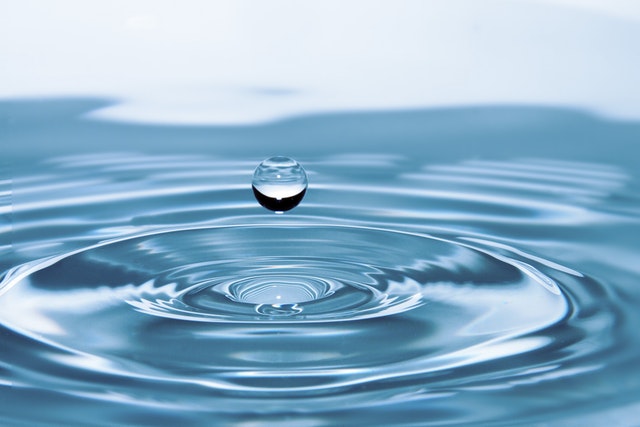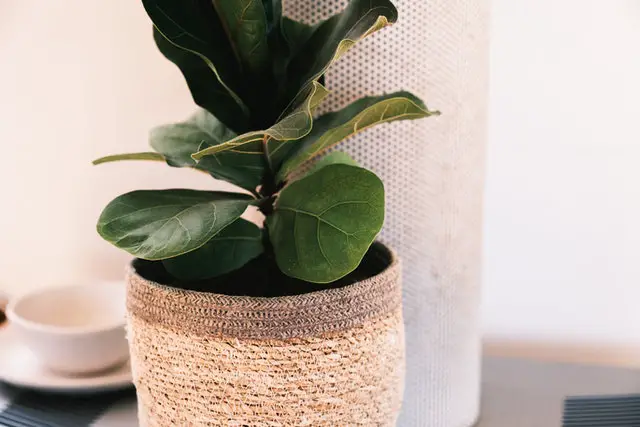Is your fiddle leaf fig curling? The Fiddle Leaf Fig Tree (Ficus Lyrata) is a beautiful large vibrant green plant that can brighten up any room. It is a gorgeous indoor plant with broad glossy elegant leaves and tall stature. The leaves vary in shape but are often broad with a narrow middle, and can reach up to 45cm in height and 30cm wide. Despite its beauty, proper care is essential to keep it healthy.
It is a quite popular houseplant; and one reputable thing about the Fiddle Leaf Fig is that it is a high-maintenance and attention seeking plant. So, it will need to be cared for properly.
However, some problems will inevitably arise while caring for this plant; and a quite common one may be Fiddle Leaf Fig leaves curling. In this article, we’ll discuss the causes of this and how to properly deal with it.
Fiddle Leaf Fig Curling

The Fiddle Fig Leaf Fig is native to the rainforests of Western and Central Africa. It is a finicky and dramatic plant that needs the boxes of all its living conditions ticked to thrive. So, if this plant is not given its required attention and care routines, it may react to this quickly and become sick.
This is why this plant is tagged as high maintenance.
So, if this happens to your Fiddle Leaf Fig, it will give certain indications of care slags and where to look when trying to fix them. One sign of an unhealthy plant is the leaves curling; this is not uncommon at all, and it sure is remediable.
There are several causes for this abnormality in your plant and to fix it, you have to find the root cause of the leaves curling and make amends. Without no further ado, let’s talk about some common causes of Fiddle Leaf Fig leaves curling;
1. Underwatering
Plants need water for their basic functioning, and relatively, water makes up a fair percentage of a plant’s components. Hence, if your plant is underwatered, then it may lead to problems in your plant’s growth.
The Fiddle Leaf Fig needs a good amount of water for its large growth and to develop broad gorgeous vibrant leaves with fairly woody stems. So, when it’s not supplied with enough water, the leaves start to curl.
Watering a plant may seem like a blur sometimes and you may not be sure when, how often, and how much to water your plant.
That’s completely normal, but a keynote to watering the plant is making sure the soil doesn’t get completely dry; the soil needs to be moist but not wet. Consider the surface of the soil before watering. Water the plant once a week or once every 10 days. This plant thrives on consistent watering and sufficient air moisture.
2. Root Rot
Root rot is a familiar horticultural issue when it comes to planting. Just like your plant will love to be provided with as much water as needed, it as well wouldn’t want to be given too much more than it requires.
Root rot is a product of overwatering, and overwatering is a result of not knowing the proper watering schedule for your plant, and other times, poorly drained soil. When the plant is overwatered, it swells up and makes the leaves turn brown which then changes to black and curls up when it is not attended to quickly.
When your plant reaches the curling stage, then you know you have to act quickly or it will soon start to fall off.
To fix this, prune the damaged roots and leaves and repot if the root is completely bad. But if not, leave the plant without watering for some time to recover. Also, check if the pot used for your plant has enough drainage holes to accommodate draining and that the soil is well-drained.
Lastly, only water the soil when the first 1-2 inches of the soil is dry.
3. Water Quality

Using the right water quality for your plant is just as important as having a consistent watering practice. Tap water is considered acidic to the plant as it contains chemicals such as chlorine and fluoride which is harmful to Fiddle Leaf Figs.
Rainwater or spring water is the ideal quality for this plant as it contains the right pH value. Warm or room temperature is also the best bet for the plant.
4. Overfeeding
This plant needs not to be fed with so much fertilizer to grow healthily, it grows best with a fertilizer with a 3:2:1 ratio of nitrogen, phosphorus, and potassium respectively. A wrong amount of fertilizers or overuse will result in the leaves of the plant curling.
This is because when the plant is overfed, mineral and salt builds up in the soil which is eventually carried to the leaves, suffocating them and drying them out.
Nevertheless, overfeeding can be fixed by shifting fertilization schedules as per the plant’s specific living requirements. So, only fertilize the plant during its growing seasons, that is, spring and summer with the 3:2:1 fertilizer.
And make sure to dilute the organic fertilizer before using it; this moderate fertilization schedule is capable of bringing the plant back to shape. Or rather, just repot the plant and use fresh soil that gives your plant a fresh start.
5. Less Nutrition/Feeding
Giving your plant fewer nutrients is just as bad as overfeeding. In caring for the Fiddle Leaf Fig plant, moderation is the most important thing. This plant requires fertilization to be supplied with the proper nutrient for food.
Through the process of photosynthesis, these nutrients are converted to sugar which then serves as food for the plant. So this means that less fertilization equals less nutrition in the soil and less feeding, and thus, could result in the leaves of the plant bearing the brunt of its irregular maintenance.
If this happens to your plant, not to worry, you just have to get the plant’s fertilization requirement right. Fertilize the plant every one-two weeks; make sure to use the 3:2:1 fertilizer well diluted in water, and spray onto the soil, not the leaves.
Also, ensure the plant is getting sufficient lighting as it is an important contribution to the plant’s feeding process.
6. Pest Infestation

Some pests like mealy bugs, aphids, white flies, scale, and mites feed on Fiddle Leaf Fig Trees. They drain the plant of its nutrients which in turn deprives the plant of sufficient food. They can be seen on the leaves or the stem of the plant.
When you notice the attack of these pests, you need to act fast. And thankfully, it is an easy fix. Use a soapy wet rag to wipe the leaves and stem of the plant thoroughly. You may also spray the solution onto the plant – use one tablespoon of dish soap in one liter of water.
Repeat this process continually until the pests are eliminated. Alternatively, you could use neem oil to clean out the plant.
7. Low Temperature Level
The ideal temperature level for a Fiddle Leaf Fig is between 65-75 degrees Fahrenheit. A slight temperature change may cause your plant to react and make the leaves dry and curl up, so endeavor to keep your plant at this level.
Keep it away from cold drafts, air conditioning units, radiators, and fans which may affect the plant. And don’t hesitate to change the position of the plant if you notice a temperature change.
8. Exposure to Direct Sunlight
Like most plants, the fiddle leaf fig needs light. Still, they do not need a lot of sunlight to thrive. If your plant’s leaves are curling and turning brown, they are possibly suffering from sunburn. White spots and brown patches may also begin to appear on the plant’s leaves. If you don’t take the fiddle leaf fig away from the sunny area, its leaves will become dry, crispy, and curly.
Fortunately, these plants can become healthy again if you place them away from direct sunlight. Preferably, place the fiddle leaf fig plant close to the east-facing window. But you may have to remove severely burned leaves as they may not survive again.
9. Low Humidity
In environments with humidity levels between 40% and 60%, your fiddle leaf fig plant will be happy. But if the humidity levels drop below 40%, the plant’s leaves will begin to curl. Also, the leaf edges may begin to change to brown.
Being native to the tropical forest, fiddle leaf figs enjoy high humidity levels. To increase your plant’s humidity levels, place a humidifier close to it or mist the leaves. Furthermore, you can place a pebble tray that contains water near the plant.
Read a related post: Sunburnt Fiddle Leaf Fig
Outro
Plants like Fiddle Fig Leaf Figs are pretty sensitive and will require a fair amount of attention. But the good part is, this gorgeous plant will let you know when you’re not doing something right.
When you notice changes in your plant, you need to examine your care routines and make sure you’re not falling back somewhere. Fiddle Leaf Fig leaves curling is a common symptom of an unhealthy plant, and it could indicate so many things.
So when you observe that your plant’s leaves are curling, you need to pay more attention to your plant. Fiddle Leaf Figs are wonderful houseplants and are worth every time you spend on them.
Frequently Asked Questions
What does an overwatered fiddle leaf look like?
An overwatered Fiddle Fig Leaf Fig will likely have brown spots around its edges and the center of its leaves. It may also show multiple yellow spots.
Do fiddle leaf figs like to be misted?
Fiddle Fig Leaf Figs thrive in a high humidity environment thanks to their nativity. It requires a 30-65% humidity level, and one of the ways to provide that is by misting; it is essential to provide humidity for your plant.
How often should you water fiddle leaf fig?
Due to its natural habitats, it also likes a fair amount of water. Hence, water the plant once a week or once every ten days. But, make sure you ascertain that the soil is dry before watering.

Hey, I’m Lisa and I’ve been an avid gardener for over 30 years. I love writing, talking and living in the garden! Feel free to connect with me on my socials below

